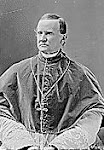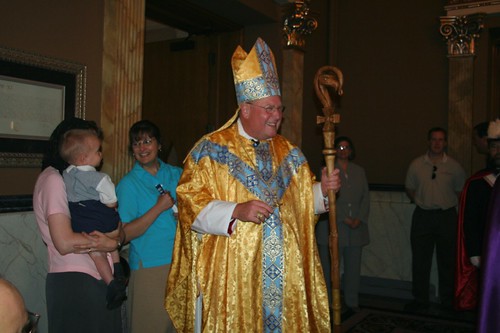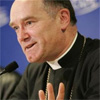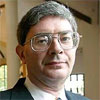
by Michael Foley
The rite of peace, which was restored to all Masses in the 1970 Missal, has fallen onto hard times. Though some Catholics wholeheartedly praise it as the "highpoint of the Mass" (as one of my priest friends has been told several times by his parishioners),

others view the matter differently. The 2005 Eucharistic Synod worries that the greeting has assumed "a dimension that could be problematic," as "when it is too prolonged" or "causes confusion."
In
Sacramentum Caritatis Pope Benedict XVI speaks of the peace becoming "exaggerated" by emotion and causing "a certain distraction" before Holy Communion.
Consequently, the Supreme Pontiff not only calls for "greater restraint" in the gesture of peace but has even raised the question as to whether it should be moved to another part of the Mass.
How could such an ostensibly bright hallmark of the new liturgy become the object of such abuse? To answer this, we must reexamine the unique but all to hidden meaning of the kiss of peace in the Roman rite.
The Holy KissThe "holy kiss," as Saint Paul calls it,
has almost always been an important component of the Mass. Originally the kiss--which was a full, lip-on-lip act--was given to members of the same and opposite sex; but by the late second century Church Fathers like Clement of Alexandria were complaining that a lascivious element between men and women was creeping into the proceedings. This problem was solved by segregating the sexes to different sides of the nave, a practice that was till being recommended as late as the 1917 Code of Canon Law.

[Pope Benedict XVI and Bartholomew I, Ecumenical Patriarch of Constantinople at Ravenna, December, 2007]Similarly, like most other kinds of kissing, the liturgical kiss was seen as a very intimate gesture, the kind of thing one would only do within one's family. Hence, the kiss was not given to "non-family members" such as heretics or catechumens. This principle was relatively easy to osbserve, since the early Church dismissed non-initiates after the homily, before the kiss was given.
The kiss remained a vital part of the liturgy until the mid-1200s, when it began to fall into disuse, and no one is certain why. The Church tried to sustain the rite by using a paten-like object called a
pax-brede. This object, which can to this day still be used even at a Low Mass, is kissed by the priest, then the servers, then the laity, in order of rank. Eventually--perhaps because of disputes within the laity over who outranked whom--the
pax-brede was restricted to the most notable dignitaries present, as we see in the 1962 rubrics.
* * * * * * *
By the time Pope Saint Pius V codified the Missal, actual kissing was no longer a part of it. The giver of the peace placed his hands on the recipient's shoulders and leaned forward towards his left cheek saying Pax tecum, to which the recipient replied, Et cum spiritu tuo.
* * * * * * *The ritual kiss remained as well, though the laity ceased taking part in it and it remained limited to Solemn High Masses. It also underwent a gradual modification. By the time Pope Saint Pius V codified the Missal, actual kissing was no longer a part of it. The giver of the peace placed his hands on the recipient's shoulders and leaned forward towards his left cheek saying
Pax tecum, to which the recipient replied,
Et cum spiritu tuo. The rubrics state that the cheeks of giver and recipient should "lightly touch," though rubricians interpreted this as "a moral, not a physical touch"!
While the Tridentine kiss may seem a bit rarified, it nevertheless maintains the phenomenology of a kiss while circumventing all of a kiss's potential drawbacks, such as the moral dangers of untoward
eros or the legitimate concern for physical hygiene. Indeed, the word "accolade," which originally meant either an embrace or a kiss marking the bestowal of knighthood, comes from the Latin
ad collum, "to the neck," because the act of falling on someone's neck betokens a kiss. (Note how the father kisses his prodigal son [Luke 15:20]). This is important, for in preserving the kiss's form, the Roman peace was still able to evince the rich tradition from which it was derived.
Moreover, the Tridentine
pax preserved an already centuries-old tradition of ordered administration. In the 1962 Missal the priest kisses the altar near the Host (earlier rubrics have him kissing the Host itself) and then "kisses" the deacon who in turn "kisses" the subdeacon and so on. No one can give the peace who has not received it from someone else, including the priest, who has received it from Christ Himself.
* * * * * * *
The symbolism is both beautiful and clear. All true peace comes from Christ through the ministration of His Church. Grace cascades from the Eucharist through Christ's ministers to His people, forming what one author has called a "chain of love" that both binds and elevates.
* * * * * * *The symbolism is both beautiful and clear. All true peace comes from Christ through the ministration of His Church. Grace cascades from the Eucharist through Christ's ministers to His people, forming what one author has called a "chain of love" that both binds and elevates. This is further echoed in the etiquette governing the ritual. While it is common in the Tridentine rite to bow to one's ecclesiastical superior at incensations, one does not acknowledge the rank of the peace-giver before it is administered, for, as the rubrics put it, "there is consideration not for the minister bringing it but for the Peace [itself]."
Placing the KissAnother important feature of the kiss in the early Church is that there were two different places where it was given. All Eastern rites and several Western rites placed the kiss somewhere around the Offertory, while the churches in Rome and North Africa placed it after the Consecration. This divergence has caused considerable confusion among liturgists, some of whom see the Roman and North African usage as an unwarranted departure from apostolic times. The kiss of peace, they claim, is inspired by our Lord's admonition to "be reconciled to thy brother" before offering "thy gift at the altar" (Mt. 5:23-24), and hence the Roman rite should, following the example of the East, have the kiss at the Offertory.
The Paschal KissWhat these authors overlook, however, is that there is not one theological rationale undergirding the kiss but two. While the Eastern kiss, which we may call the "conciliatory kiss," is indeed grounded in Matthew 5:23-24, the Roman kiss, which we may label the "Paschal kiss," takes its bearing not from the Sermon on the Mount but from the Paschal mystery stretching from the Last Supper to the Resurrection. That Paschal kiss has at least four distinct meanings.
PeaceFirst and foremost, the Roman kiss not only betokens peace but confers it. The kiss was seen not as a "sign of peace" or even
the sign of peace--it
was peace. The Roman liturgical books simply refer to the kiss as the
pax. While this may certainly include reconciliation and forgiveness, the peace itself, as the 2004
Redemptionis Sacramentum explicitly states, is not done primarily for this reason.
The Risen ChristSecond, the Paschal kiss symbolizes the Paschal Lamb, the resurrected and glorified Christ. In Saint John's Gospel, the risen Jesus appears to the Apostles and, after saying "Peace be with you," breathes the Holy Spirit upon them, a breath that gives them the power to forgive sins (John 20:20-23). Though the Latin Fathers rightly interpreted this passage as the institution of the sacrament of Penance, they also saw Christ's communication of the Holy Spirit through His breath as a kind of kiss. Hence the whole scene is redolent of the kiss of peace.
Similarly, in the story of the disciples of Emmaus, the Risen Lord meets two men, explains the Scriptures to them, and is recognized by them only in the breaking of the bread. Significantly, the text does not state that they went on to eat but that they raced back go Jerusalem to tell the Apostles, and that when they were describing what had happened, Jesus stood in their midst and said, "Peace be to you" (Luke 24:35-36). The story then ends by stating that Christ, to prove that He was not a ghost, ate some food and gave it to the others to eat. In other words, the Emmaus Resurrection story recapitulates the traditional Roman order of the Mass, from the Mass of the catechumens to the
fractio panis to the rite of peace to the communion rite.
* * * * * * *
The Roman kiss, which we may label the "Paschal kiss," takes its bearing not from the Sermon on the Mount but from the Paschal mystery stretching from the Last Supper to the Resurrection.
* * * * * * *The traditional allegorical interpretations of the Mass are also telling in this regard. Just as the Canon was seen to signify not simply the Last Supper but the various stages of our Lord's Passion, the kiss of peace was tied to the glory of the first Easter Sunday. "Peace be with you," as Saint Thomas Aquinas notes, is our Lord's signature greeting only after rising from the dead, and thus he interprets the three signs of the Cross the priest makes when saying "May the peace of the Lord be ever with you" as a mystical representation of the Ressurection on the third day.
Moreover, in the traditional Roman rite the breaking of the Host and the subsequent dropping of a Particle into the Chalice take place immediately before the peace. The medieval doctors were quick to see in the
fractio panis "the rending of Christ's body" during the Passion
or the separation of His soul and body at the moment of His death. Similarly, they noted how the commingling of the Species aptly signifies the Resurrection, for the commingling of the sacred Body and Blood calls to mind the Easter reunion of all that had been sundered on Good Friday.
The Holy SpiritThird, drawing from John 20:23, the
pax represents the breath of the Holy Spirit. In a particularly charming sermon, Saint Augustine expatiates about how the tender kisses of doves, symbols of the Holy Ghost, are examples of how Christians should administer the Paschal kiss, the he contrasts their chaste necking with the unkind kisses of ravens, who purportedly lacerate each other when they engage in osculation.
Chilling Counter-exampleFourth, the allegedly nasty way that ravens smooch was also for Augustine the perfect emblem for Judas Iscariot's notorious greeting to our Lord in Gethsemane. The irony that Christ was betrayed by the same sign that is paradigmatic of peace and fraternal charity was not lost on the Church Fathers, and thus the Judas kiss served as a chilling reminder of the grave danger of hypocrisy. It is for this reason that the kiss of peace is not given on Maundy Thursday in the Traditional rite, as the bitter aftertaste of the traitor's kiss is too fresh, too vivid, for those who take seriously the kiss of peace.
PedagogueFinally, as Aquinas notes, the Paschal kiss helps us prepare for Holy Communion (III.83). This might sound odd given that today it is held in suspicion precisely because it seems to distract m ore than prepare, but this may have less to do with its placement than with the way it is currently observed.

[At the Episcopal Ordination and Installation of H.L. Bishop Camillo Ballin as Vicar Apostolic of Kuwait, Sept. 2, 2005, the newly ordained Bishop sets aside his staff and receives the kiss of peace from Bishop Francis Micallef, the retiring Vicar Apostolic of Kuwait, Archbishop Giuseppe De Andrea, the retiring Apostolic Nuncio to Kuwait, the other participating Bishops and all the members of the clergy present.]
In sum, these various meanings illustrate how the Roman kiss is a Paschal kiss, a kiss that flows from the Passion, Death, and Resurrection of Jesus Christ rather than from His Sermon on the Mount. While this in no way depreciates the value of the Eastern conciliatory kiss, it does suggest that the two traditions are not interchangeable.
Peace in the New MissalVatican II's
Constitution of the Sacred Liturgy does not mention the kiss of peace, though it robustly affirms the Mass as "a sacrament of love, a sign of unity, a bond of charity, a Paschal banquet" (47), characterizations which elide nicely with the symbolic meanings of the
pax we have been exploring.
Rather than restore the traditional Paschal kiss to those outside the sanctuary, however, the 1970 Novus Ordo mandates a different arrangement. The priest now says to the people: "Offer the peace to yourselves."
The following is then supposed to happen: "And all signify to each other peace and charity, in accordance with local custom. The priest gives the peace to the deacon or server."
By mentioning the priest's actions after those of the people, the new rubrics do not presuppose a causal relationship between the two. No longer is there expected a hierarchical cascading of peace from the embty tomb that is the high altar; rather, in insctucting the congregation to offer the peace to each other, there is a more or less spontaneous eruption of peace in the pews.
* * * * * * *
It is now more difficult to trace the link between the risen Eucharistic Christ and the peace He diffuses to His Churc, for the "chain of love" has ceased to be visible. The vertical mediation of Christ's peace has been replaced by horizontal immediacy.
* * * * * * *Even aside from the excess that Pope Benedict laments have come from this arrangement, it is now more difficult to trace the link between the risen Eucharistic Christ and the peace He diffuses to His Churc, for the "chain of love" has ceased to be visible. The vertical mediation of Christ's peace has been replaced by horizontal immediacy. It is therefore not surprising that contemporary liturgiology has tended to emphasize the conciliatory function of the peace, thus conflating the two traditions.
Further complicating the new
pax is the decision to let its gesture be determined by local custom.
In many respects this is not unreasonable, for there are several places that associate public kisses with lewdness.
Yet as we have already seen, what became the Roman form of the kiss can hardly be considered lascivious by even the most prudish culture, since not even the cheeks of the participants touch.
In America, the form that quickly came to dominate is the handshake. Again,
prima facie this is not an unreasonable choice: as an indication that one is unarmed, the handshake is certainly as sign of peace. Unfortunately, though, it is a better sign of the peace that comes from the city of man rather than from the city of God. Handshaking signifies a truce or deal, the kind of agreement one makes in politics and business. It is not primarily a sign of love or intimacy. Indeed, unlike the kiss and every other sacred gesture, it has undergone no modification that would mark it as distinctive from the "profane" handshakes outside the liturgy, and thus it essentially retains its wordly resonance.
Moreover, a handshake is not a kiss in any form, and hence its liturgical use marks a break not only from a previously unbroken apostolic custom but from the rich cluster of meanings that came with it. It is for these reasons that a more pugnacious commentator than I might be tempted to conclude that regrettably, the current Roman kiss of peace is neither Roman nor a kiss nor about Christian peace.
ConclusionIt will be interesting to see whether in this post
Motu Proprio era the kiss in the extraordinary form will ever be shared again with the laity or if the pax-brede will make a comeback. On the other hand, the crisis in the ordinary form appears to require a swifter return to tradition. Re-embracing the Paschal meaning of the Roman rite of peace could considerably enhance the Novus Ordo, just as replacing the horizontally spantaneous handshake with the hierarchically mediated accolade would recapture not only a sense of emotional restrain and gracefulness but a powerful theology of the Paschal mystery. Indeed, helping the new Mass rediscover rather than reinvent the kiss could be one of the traditional rite's greatest gifts to it, and thus it would contribute to the Holy Father's goal of the two missals "mutually enriching" each other.
How sweet a kiss that would be.
Notes
 My friend Eric passes along some reliable heresay, which I paraphrase:
My friend Eric passes along some reliable heresay, which I paraphrase:


































 The rite of peace, which was restored to all Masses in the 1970 Missal, has fallen onto hard times. Though some Catholics wholeheartedly praise it as the "highpoint of the Mass" (as one of my priest friends has been told several times by his parishioners),
The rite of peace, which was restored to all Masses in the 1970 Missal, has fallen onto hard times. Though some Catholics wholeheartedly praise it as the "highpoint of the Mass" (as one of my priest friends has been told several times by his parishioners),  others view the matter differently. The 2005 Eucharistic Synod worries that the greeting has assumed "a dimension that could be problematic," as "when it is too prolonged" or "causes confusion."
others view the matter differently. The 2005 Eucharistic Synod worries that the greeting has assumed "a dimension that could be problematic," as "when it is too prolonged" or "causes confusion."

 letter to the bishops accompanying Summorum Pontificum. [
letter to the bishops accompanying Summorum Pontificum. [

 Last year,
Last year,  This point was made recently in an article by George Weigel:
This point was made recently in an article by George Weigel:  Marcel Lefebvre’s war, in other words, was not simply, or even primarily, against modern liturgy. It was against modernity, period. For modernity, in Lefebvre’s mind, necessarily involved aggressive secularism, anti-clericalism, and the persecution of the church by godless men. That was the modernity he knew, or thought he knew (Lefebvre seems not to have read a fellow Frenchman’s reflections on a very different kind of modernity, Alexis de Tocqueville’s "Democracy in America"); it was certainly the modernity he loathed. And to treat with this modernity—by, for example, affirming the right of religious freedom and the institutional separation of church and state—was to treat with the devil.
Marcel Lefebvre’s war, in other words, was not simply, or even primarily, against modern liturgy. It was against modernity, period. For modernity, in Lefebvre’s mind, necessarily involved aggressive secularism, anti-clericalism, and the persecution of the church by godless men. That was the modernity he knew, or thought he knew (Lefebvre seems not to have read a fellow Frenchman’s reflections on a very different kind of modernity, Alexis de Tocqueville’s "Democracy in America"); it was certainly the modernity he loathed. And to treat with this modernity—by, for example, affirming the right of religious freedom and the institutional separation of church and state—was to treat with the devil.